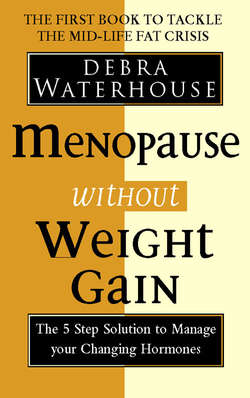Читать книгу Menopause Without Weight Gain: The 5 Step Solution to Challenge Your Changing Hormones - Debra Waterhouse - Страница 10
When Fat Cells Turn 45
ОглавлениеWhen you reach your mid-forties, your oestrogen levels are declining more significantly, your body changes are no longer subtle, and there is no question in your mind that you are in the perimenopause.
• Your periods have changed – sometimes longer, other times shorter; sometimes heavier, other times lighter.
• You are craving chocolate all month long and keeping chocolate everywhere – in your bag, briefcase, desk drawer and anywhere else that’s feasible. You may be forgetting people’s names and appointment times, but chocolate is excluded from your memory loss.
• You continue to lose half a pound of muscle a year, and your caloric needs drop by as much as 400 calories a day. If you are eating the same amount, you are storing most of those 400 calories in your waist.
• You have gained up to 10 pounds of fat and are more frustrated with your weight than ever before.
• One-size-fits-all labels have crept into your cupboard, along with elastic-waisted trousers and skirts.
• You are considering liposuction or any other procedure to get rid of this unwanted fat.
• Your fat cells start reproducing and multiplying to make sure there is plenty of room to store fat and produce the oestrogen you need. In other words, you may not be able to give birth any longer, but your fat cells still can.
Fat cells giving birth? Many women aren’t happy to hear that their fat cells are reproducing, but it’s another one of their highly evolved functions during the perimenopause. Because your ovaries’ output of oestrogen is now below normal, fat cells start dividing as a safeguard for oestrogen production. Their new motto is ‘divide and conquer.’
When you are in your mid-to late forties, your menopausal fat cells are working together like an ant colony, some dividing, others expanding, and all managing to store unbelievable amounts of calories in their microscopic containers. All of this hard work is to make sure you are gaining ample weight in your waist so that your abdominal fat cells can provide a natural source of oestrogen.
By now, your fat cells have been so successful in stimulating weight gain in your upper body that a change in body shape is apparent. Your waist has increased by 2 inches, and your pear-shaped body has become noticeably more apple-shaped. This shift in body shape is pleasing to some women. It was to my friend Stephanie. After being pear-shaped since puberty and having to buy smaller-size tops than bottoms for the previous 30 years, she welcomed a more even weight distribution. She came walking out of a room one day modelling her new apple-shaped body for appraisal and asked, ‘What do you think? Red delicious or Granny Smith?’ We all agreed she was red delicious – and proud of it.
This is what Stephanie’s and your 45-year-old fat cells look like:
As you approach the 50-year mark, your body and fat cells continue to change, and you are reading everything that you can get your hands on about the menopause. It becomes the number one topic of conversation with your friends and the number one concern with your doctor. Then as you round your fifth decade, your fat cells reach a new equilibrium. Their job is done.
